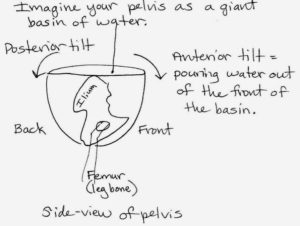
Pelvic Control Precedes Core Control
For any of you who have followed this blog for a while, the pelvis has been a long-standing fixation of mine. It has routinely been the deciding factor in moving better and getting out of pain (particularly low back pain). Boldy put, if you can’t control your pelvis, you’re wasting the marvel of your core. The core is more than just your abs. It’s “anything between the hips and shoulders“. All of this fascinating mass sits on a pelvic bowl that tips the connective musculature for or against you.
Our western sitting culture makes us prime candidates for thick, strong hip flexors. The body’s smart. If we repeatedly ask it to reside in a hip flexed position it will adapt to make it easier for us. The pelvis rotates anteriorly to compensate. Dominant hip flexors leave less work for the lower abs. A thin sheet of paper (deep abs) will not compete well with hefty ropes (hip flexors) to provide movement. Training in anterior pelvic tilt only compounds matters. Hip flexor bullies become beasts that override the inside-out sequencing that is meant to engage our core at all times. We are left with limb-driven movement in which the core follows instead of leads.
Living in the extreme of anterior pelvic tilt means neutral can be found by practicing posterior pelvic tilt.
The same questions asked to control any movement apply to pelvic positioning:
Can you get it there? and
Can you keep it there?
When trying to establish pelvic tilt in a new position, giving yourself a contrast allows you to feel for the opposite. You can recognize ‘good’ when you deliberately put yourself in ‘bad’. Watch the contrast here to start this dead bug regression:
Hands facing up and at sides takes relaxed shoulders out of the movement.
This small limb movement becomes challenging when you have to work to keep the torso locked down. In posterior tilt, the hip flexors become disadvantaged. A move many would feel in the upper thigh becomes concentrated in the lower abs. The biomechanics of posterior pelvic tilt slackens the hip flexors shifts the load to the core.
When lying on your stomach, discomfort in the low back is often caused by gravity pulling down on a particular hinge point between the low back and the butt. If you can learn to posteriorly tilt from a prone orientation, this issue can be alleviated. Furthermore, as you begin to work on face-down hip work, any twinges in the low back will provide feedback that you’ve slipped back into anterior pelvic tilt (or APT). Pain is one heck of a communicator.
As simple as it may sound, understanding how to posterior tilt from a prone position can be tricky. You have to be able to drive your knees into the ground. Elevating the feet allows you to get a bit more leverage to concentrate the force of movement:
The second, knee bent version is a regression, shortening the lever to minimize interference.
This sets the stage for planks, but raised feet and chest compete for work the core is meant to do. Leaving the hips and shoulders on the ground puts them on the same plane as the abdominals and concentrates the tension on the anterior line. The core acts as a unit instead of divided contradiction:
Hanging leg raises and knee tucks also become very distinctive when preceded by a posterior pelvic tuck:
It feels as different as it looks.
The mobility slant on core work is the more tension the torso can generate, the freer the limbs should be to move. Here some three-limbed rolls give way to greater hip flexion and abduction:
TO REVIEW:
- A thin sheet of paper cannot compete with hefty ropes
- Anterior pelvic tilt is countered by practicing posterior pelvic tilt
- Posterior pelvic tilting slackens the hip flexors and creates tension in the abs
- Contrast movements to get a feeling for the desired opposite
- Elevating the feet creates a feedback rich learning environment for prone pelvic tilting
- Go armless with planks on the tops of the feet to get a feel for unified core work
- Posterior tilting alone from the hang is enough to get those abs fired up
- Core tension generates limb range of motion





Excellent article.
You are amazing! Thank you for sharing all that you do 🙂